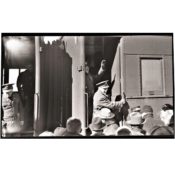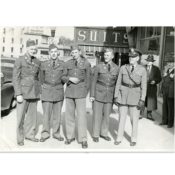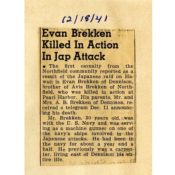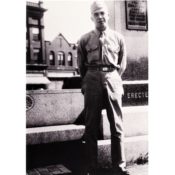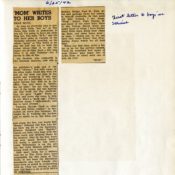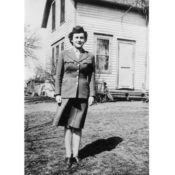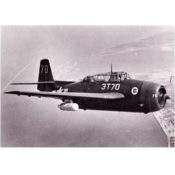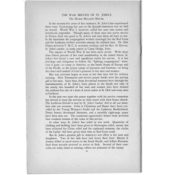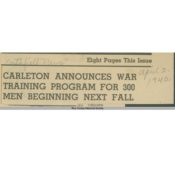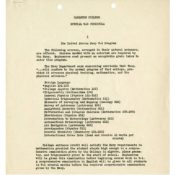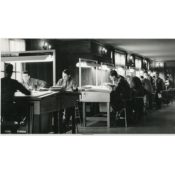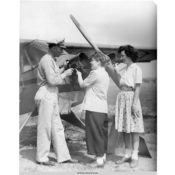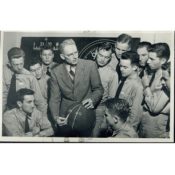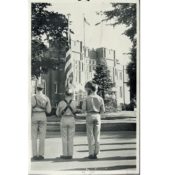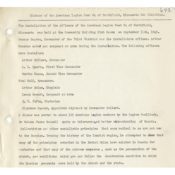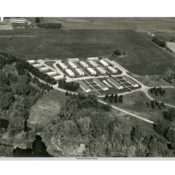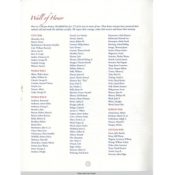
By Stephanie Hess, Northfield-Rice County Digital History Collection, January 2019
World War II started in Europe on September 1, 1939, but the United States did not join right away. On December 7, 1941, the Japanese military bombed the United States Navy’s Pacific fleet at Pearl Harbor in Hawaii. Then the U.S. government declared war on Japan and its allies, including Germany.
Young men from Northfield joined more than 12 million Americans to serve in the armed forces. Some were members of the Northfield National Guard unit that was activated for federal duty. Others enlisted in the U.S. Army, Navy, Marine Corps, Army Air Force, or Coast Guard. Some soldiers had special skills and were commissioned to serve as officers, especially medical doctors. Many others were drafted.
Northfield women joined the armed forces, as well. They served as nurses in the U.S. Army Nurse Corps or U.S. Navy Nurse Corps at bases in the United States and all over the world. Others held noncombat positions in the U.S. Naval Reserve’s Women Accepted for Volunteer Emergency Services (WAVES) unit or the Women’s Army Corps (WAC).
Other Northfield citizens contributed to the war effort on the home front. They sent letters and copies of the Northfield News to soldiers. They joined the Northfield Red Cross for service projects and fundraising. They practiced air raids and blackouts. The city organized scrap drives to collect metal, rubber, paper, and kitchen fat. Northfielders also purchased defense savings bonds to fund the war.
Early in 1942, rationing for the war began. This meant that Northfielders could only use small amounts of certain materials, food, and gasoline. They had to use ration stamps to buy beef, sugar, lard, and butter. Many households planted victory gardens to grow their own food. Local farmers raised and sold grain, vegetables, fruit, and geese and rabbit meat. The Washington School even opened a canning center to teach the community how to preserve the fruit and vegetables they had grown.
The war also affected both colleges in town. The number of enrolled students at Carleton College and St. Olaf College plummeted. Many male students enlisted or were drafted by the military. By the end of the war, over 3,000 Carleton and St. Olaf students and alumni had served in the armed forces.
Northfield’s colleges were not empty during the war, however. In December of 1942, the U.S. Army created a Basic Pre-Meteorology Training Course at Carleton College. Carleton also hosted a detachment of the Army Air Force Technical Training Command and an Army Specialized Training Program for language studies and basic engineering.
St. Olaf College also became a temporary home for military trainees. In 1942, the U.S. Navy opened a Naval Pre-Flight Preparatory School on campus. Later, St. Olaf hosted a Navy Academic Refresher Unit (V-5) that trained officers of the Marines, Coast Guard, and Navy. The campus was also home to a Cadet Nurses Training Corps program for women during the summers of 1944 and 1945.
To support the military personnel in town, Northfield formed a local United Service Organization (U.S.O.) branch. Led by Sara Clark, the Northfield U.S.O. organized committees of cookie bakers and hostesses. It found housing for soldiers during holidays and for their families. The U.S.O. also was in charge of dances at the high school and other forms of entertainment for the soldiers.
The people of Northfield sacrificed much for the war effort. Their patriotism and participation helped contribute to the ultimate victory on all fronts of this worldwide conflict.
Primary Sources
Discussion Questions
When you look at the individual items in the Northfield-Rice County Digital History Collection, use the zoom-in tool to view details in the images or more easily read the documents. Use the tab labeled “TEXT” to read full transcriptions of the documents.
Questions
- If the United States were attacked like we were at Pearl Harbor, would you want to join the military and fight back? Why or why not? Which branch of the military would you choose: Army, Navy, Air Force, Marines, Coast Guard, or an entirely new branch? Why?
- We think of war service as combat, but how else did the people of Northfield serve during World War II? Come up with a list of all the jobs that need to be done to win a war. What would be the hardest to do? The easiest? The scariest?
- In World War II, women had many new opportunities to serve in the military. Why is this significant?
- Take a closer look at this photograph from Carleton College. Ask yourself: Who is in the photograph? What are they doing? What are they wearing and holding and why? What does it say about women during World War II? Who took the photo? Why was it taken? What message is it trying to send? Now ask those questions about this St. Olaf College photograph as well. How are they similar? How are they different?
- How did the war affect families in Northfield like the McGuires? Think about other types of families, too, including church communities and the I.O.O.F. home for children.
- Compare and contrast the wartime experiences of those who served in Europe or the Pacific with those who stayed on the home front. How were they the same? How were they different?
- Why do you think Carleton and St. Olaf Colleges agreed to let the military use their facilities for training programs? How did the military presence affect the college communities as well as the town as a whole?
- Why are there so many examples of “fun” activities during World War II in the set above? (See the program and the winter activities; also look through more of the St. Olaf and Carleton World War II collections). What purpose did these diversions serve?
- How did Northfield help the veterans when they returned? How were they honored? Why were they honored? See the American Legion history, veterans’ housing, and veterans’ memorial items for more details.
- Why do you think people who lived during World War II are called the Greatest Generation?
Related Items in the Northfield-Rice County Digital History Collection
Carleton College World War II photographs and documents
Eugene H. Truax Veterans of Foreign Wars Post #4393 photograph collection
Nellie “Mom” Phillips Northfield News Scrapbook 1, Scrapbook 2, and Scrapbook 3
Resume of Service Men from Waterford
Additional Resources
Lesson Plans
Classroom Resources for Teachers. The National WWII Museum. Web (accessed September 20, 2018).
On the Home Front. EDSITEment lesson plan for grades 3-5 published by the National Endowment for the Humanities on October 3, 2010. Web (accessed September 20, 2018).
The Road to Pearl Harbor: The United States and East Asia, 1915-1941. EDSITEment curriculum unit for grades 9-12 created by the National Endowment for the Humanities. Web (accessed September 20, 2018).
The United States in World War II: “The Proper Application of Overwhelming Force.” EDSITEMENT curriculum unit for grades 9-12 created by the National Endowment for the Humanities. Web (accessed September 20, 2018).
World War II Teaching Resources. © 2018 Scholastic Inc. Web (accessed September 20, 2018).
Bibliography
Headley, Leal A. and Merrill E. Jarchow. Carleton: The First Century. Northfield, MN: Carleton College, 1966.
Hvistendahl, Susan. Historic Happenings, Vol. I: Selected Entertainment Guide columns. Northfield, MN: Northfield Historical Society Press and The Entertainment Guide, 2014.
Kaplan, Anne R. “Fifty Years Ago—Exploring World War II at the Minnesota Historical Society.” Minnesota History Quarterly (Volume 54, No. 7, pp. 316-322). Available on the web (accessed September 19, 2018).
“Minnesota’s Greatest Generation.” Minnesota Historical Society. Web (accessed September 19, 2018).
Shaw, Joseph M. History of St. Olaf College: 1874-1974. Northfield, MN: The St. Olaf College Press, 1974.
Supplement to To Honor and Remember: Northfield 1945-1995. Northfield, MN: WWII Commemoration Committee, 1995.
To Honor and Remember: Northfield 1945-1995. Northfield, MN: WWII Commemoration Committee, 1995.
Women and the Home Front During World War II: Overview. LibGuide by the Minnesota History Center Gale Family Library. Web (accessed September 19, 2018).
Women in the Military – WWII: Overview. LibGuide by the Minnesota History Center Gale Family Library. Web (accessed September 19, 2018).
Primary Source Analysis
Here are some tips for analyzing the primary sources found above and throughout the DHC. For each source, ask students to indicate:
- the author’s point of view
- the author’s purpose
- historical context
- audience
For inquiry-based learning, ask students to:
- explain how a source tells its story and/or makes its argument
- explain the relationships between sources
- compare and contrast sources in terms of point of view and method
- support conclusions and interpretations with evidence
- identify questions for further investigation
Additional Tools
- Document Analysis Worksheets from the National Archives
- Teaching with Primary Sources Videos and Sets from the Minnesota Historical Society
- Using Primary Sources from the Library of Congress
Minnesota Education Standards
Here is a list of education standard codes for benchmarks that can be explored using this Primary Source Set.
- 1.4.1.2.1, 1.4.1.2.2
- 2.4.1.2.1
- 3.4.1.2.1
- 5.4.1.2.1
- 6.4.1.2.1, 6.4.4.21.4
- 7.4.1.2.1, 7.4.4.21.3
- 9.4.1.2.1, 9.4.3.12.3, 9.4.4.21.6
- 1.8.7.7
- 2.8.7.7
- 3.2.7.7, 3.6.2.2, 3.6.7.7, 3.6.8.8, 3.8.2.2, 3.8.7.7, 3.8.8.8
- 4.2.7.7, 4.6.2.2, 4.6.7.7, 4.6.8.8, 4.8.2.2, 4.8.7.7, 4.8.8.8
- 5.2.7.7, 5.6.2.2, 5.6.7.7, 5.6.8.8, 5.8.2.2, 5.8.7.7, 5.8.8.8
- 6.12.1.1, 6.12.2.2, 6.12.4.4, 6.12.7.7, 6.12.9.9, 6.14.2.2, 6.14.7.7, 6.14.8.8
- 9.12.1.1, 9.12.2.2, 9.12.4.4, 9.12.7.7, 9.12.9.9, 9.14.2.2, 9.14.7.7, 9.14.8.8
- 11.12.1.1, 11.12.2.2, 11.12.4.4, 11.12.7.7, 11.12.9.9, 11.14.2.2, 11.14.7.7, 11.14.8.8
Send us feedback about this primary source set.
This publication was made possible in part by the people of Minnesota through a grant funded by an appropriation to the Minnesota Historical Society from the Minnesota Arts and Cultural Heritage Fund. Any views, findings, opinions, conclusions or recommendations expressed in this publication are those of the authors and do not necessarily represent those of the State of Minnesota, the Minnesota Historical Society, or the Minnesota Historic Resources Advisory Committee.

